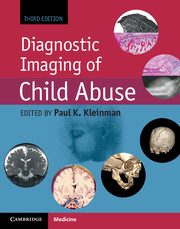Book contents
- Frontmatter
- Dedication
- Contents
- List of Contributors
- Editor’s note on the Foreword to the third edition
- Foreword to the third edition
- Foreword to the second edition
- Foreword to the first edition
- Preface
- Acknowledgments
- List of acronyms
- Introduction
- Section I Skeletal trauma
- Chapter 1 The skeleton: structure, growth and development, and basis of skeletal injury
- Chapter 2 Skeletal trauma: general considerations
- Chapter 3 Lower extremity trauma
- Chapter 4 Upper extremity trauma
- Chapter 5 Bony thoracic trauma
- Chapter 6 Dating fractures
- Chapter 7 Differential diagnosis I: diseases, dysplasias, and syndromes
- Chapter 8 Differential diagnosis II: disorders of calcium and phosphorus metabolism
- Chapter 9 Differential diagnosis III: osteogenesis imperfecta
- Chapter 10 Differential diagnosis IV: accidental trauma
- Chapter 11 Differential diagnosis V: obstetric trauma
- Chapter 12 Differential diagnosis VI: normal variants
- Chapter 13 Evidence-based radiology and child abuse
- Chapter 14 Skeletal imaging strategies
- Chapter 15 Postmortem skeletal imaging
- Section II Abusive head and spinal trauma
- Section III Visceral trauma and miscellaneous abuse and neglect
- Section IV Diagnostic imaging of abuse in societal context
- Section V Technical considerations and dosimetry
- Index
- References
Chapter 9 - Differential diagnosis III: osteogenesis imperfecta
from Section I - Skeletal trauma
Published online by Cambridge University Press: 05 September 2015
- Frontmatter
- Dedication
- Contents
- List of Contributors
- Editor’s note on the Foreword to the third edition
- Foreword to the third edition
- Foreword to the second edition
- Foreword to the first edition
- Preface
- Acknowledgments
- List of acronyms
- Introduction
- Section I Skeletal trauma
- Chapter 1 The skeleton: structure, growth and development, and basis of skeletal injury
- Chapter 2 Skeletal trauma: general considerations
- Chapter 3 Lower extremity trauma
- Chapter 4 Upper extremity trauma
- Chapter 5 Bony thoracic trauma
- Chapter 6 Dating fractures
- Chapter 7 Differential diagnosis I: diseases, dysplasias, and syndromes
- Chapter 8 Differential diagnosis II: disorders of calcium and phosphorus metabolism
- Chapter 9 Differential diagnosis III: osteogenesis imperfecta
- Chapter 10 Differential diagnosis IV: accidental trauma
- Chapter 11 Differential diagnosis V: obstetric trauma
- Chapter 12 Differential diagnosis VI: normal variants
- Chapter 13 Evidence-based radiology and child abuse
- Chapter 14 Skeletal imaging strategies
- Chapter 15 Postmortem skeletal imaging
- Section II Abusive head and spinal trauma
- Section III Visceral trauma and miscellaneous abuse and neglect
- Section IV Diagnostic imaging of abuse in societal context
- Section V Technical considerations and dosimetry
- Index
- References
Summary
Osteogenesis imperfecta
Of the many conditions that may be confused with child abuse, osteogenesis imperfecta (OI) deserves special consideration. Although this is a relatively rare disorder (1 in 20,000 births), cases of OI have been initially confused with inflicted skeletal injury. As will be apparent from the discussion in this chapter, such confusion is avoidable in most cases if a thorough clinical, radiologic, and molecular evaluation is carried out. A heightened public awareness of OI has created considerable controversy and has added a new dimension to the diagnostic imaging of suspected child abuse (1–13).
In recent years, many cases of children with features of inflicted trauma have had the flag of the OI defense raised by the children’s caretakers and their attorneys, as well as the plaintiffs’ legal representatives in other civil litigations. It has been well known since the earliest description of OI by Ekman in 1788 and Axmann’s (his own and his family’s) description in 1831 that fractures with minimal trauma are an important part of this disease complex (14, 15).
To differentiate OI from child abuse, it is necessary to understand the disease not only radiologically and clinically, but also appreciate the distinct histologic, biochemical, and molecular abnormalities associated with this important condition.
- Type
- Chapter
- Information
- Diagnostic Imaging of Child Abuse , pp. 254 - 267Publisher: Cambridge University PressPrint publication year: 2015
References
- 2
- Cited by



